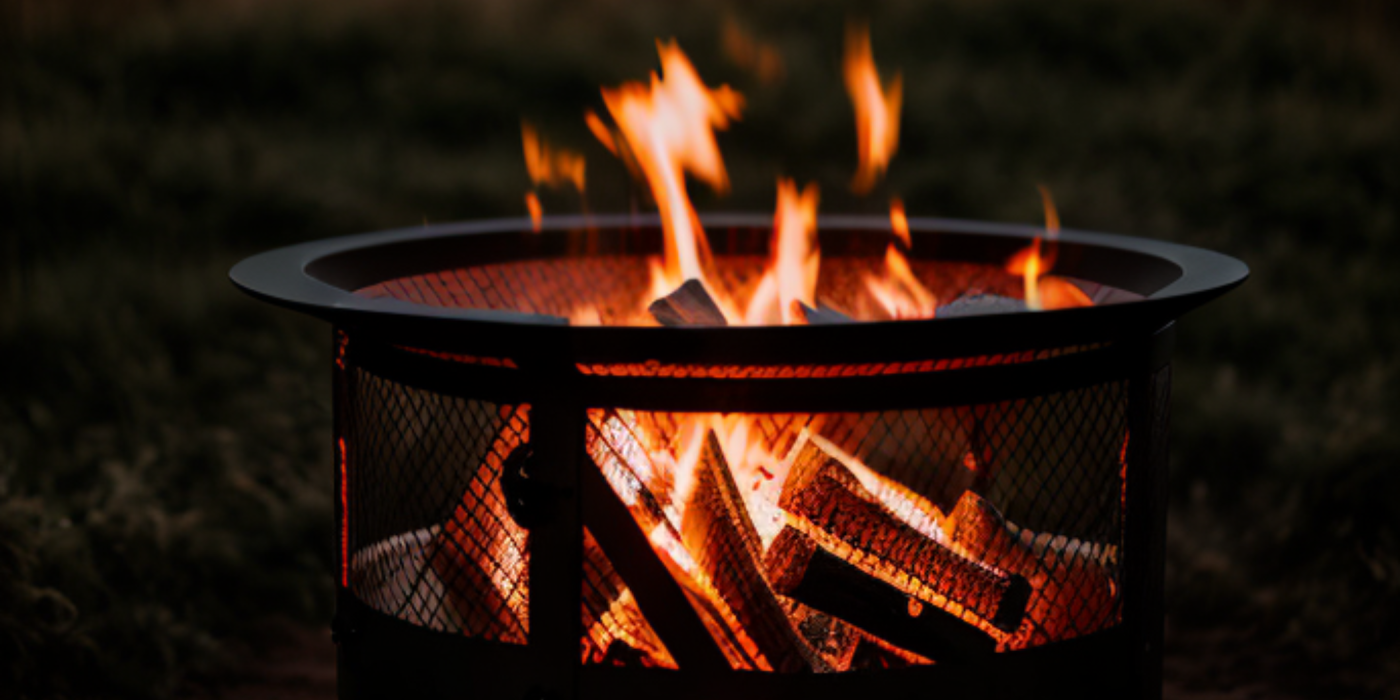What to Burn in a Fire Pit Without Smoke

There's something particularly magical about a fire pit. The glow of the flames, the warmth permeating the cool evening air, and the alluring dance of the firelight against the dark night sky create a unique, homely atmosphere. Fire pits, whether nestled in a cosy garden or set up on a spacious patio, have long been a beloved centrepiece for outdoor gatherings, offering not only warmth but also a space for storytelling, singing, roasting marshmallows, or simply sharing silence under the stars.
The Issue with Smoke
Despite the beauty and warmth they provide, fire pits often produce smoke, an unwanted byproduct that can lead to several issues. Smoke can cause health problems such as eye irritation, respiratory issues, and allergy symptoms. It also contributes to air pollution, having a negative impact on the environment. Furthermore, the strong odour that lingers on clothing and furnishings is less than ideal, and smoke can even lead to disputes with neighbours over air quality.
The Objective of this Article
The aim of this article is to provide a comprehensive guide to enjoying your fire pit without the downside of smoke. We'll explore a variety of fuel sources, fire pit models, and techniques that significantly reduce or even eliminate smoke production. This way, you can bask in the joy of your outdoor fire pit without worrying about the negative impacts associated with smoke. We'll also discuss eco-friendly alternatives and the legal considerations in the UK, helping you make an informed and responsible choice for your fire pit experience.
Understanding Fire Pits and Smoke Production
What are Fire Pits and How Do They Work?
Fire pits, in essence, are simple constructions that allow us to contain and control outdoor fires. They can range from basic dug-out pits in the earth to intricate, store-bought models constructed from metal, brick, or stone. Regardless of the design, their primary function remains the same: to hold fire in a controlled manner, primarily for heat, cooking, or simply for the pleasure of a beautiful outdoor fire.
The Science Behind Smoke Production
Smoke is a natural by-product of combustion, the process where fuel is combined with oxygen to produce heat. However, smoke is primarily produced when the combustion is incomplete - when not all the fuel is efficiently burned. This often happens when there's not enough oxygen or the fuel isn't dry or properly prepared. Wet or green wood, for instance, tends to smoke more than dry, seasoned wood. This is because the energy from the fire first has to evaporate the moisture before the wood itself can burn, leading to inefficient combustion and consequently, more smoke.
The Drawbacks of Smoke
While a small amount of smoke may seem harmless or even cosy to some, excessive smoke can lead to several issues. Health-wise, prolonged exposure to smoke can lead to respiratory problems and eye irritation, among other concerns. From an environmental perspective, smoke contributes to air pollution. Additionally, the strong odour that smoke produces can often be unpleasant and linger on clothes or furniture. Lastly, smoke can also lead to complaints from neighbours, especially in densely populated areas, potentially leading to strained relationships or even legal troubles.
Suitable Fuel Sources for a Smokeless Fire
Smokeless fires are a delight, allowing you to enjoy the warmth without dealing with the smoke that can ruin the experience. The secret to achieving this is choosing the right fuel source.
Dry, Seasoned Wood
When it comes to wood, not all types are created equal. Dry, seasoned wood, for instance, burns hotter and cleaner than its green, unseasoned counterpart. This type of wood has been left to dry over time, reducing its moisture content and making it an excellent choice for your fire pit. It produces less smoke due to the reduced moisture, while also offering a higher heat output.
Advantages of Seasoned Wood
Seasoned wood offers multiple advantages. Not only does it produce less smoke, but it also lights up more easily, meaning you'll spend less time getting your fire started and more time enjoying it. Its high heat output also means that a small amount can last a long time, making it a cost-effective option.
Kiln-Dried Wood
An alternative to seasoned wood is kiln-dried wood. This wood undergoes a drying process in a kiln, a kind of oven. This makes the wood incredibly dry and easy to light, and when burned, it produces minimal smoke.
Smokeless Fuel Alternatives
Aside from wood, there are other smokeless fuel alternatives that you can consider. Gas fire pits, for instance, are popular for their convenience and cleanliness. Bio-ethanol is another option, known for its high heat output and low emissions. While these options might not offer the traditional fire pit experience, they do provide a hassle-free, smokeless solution for your outdoor heating needs.
Smokeless Fire Pit Models
Overview of Specially Designed Smokeless Fire Pit Models
Smokeless fire pits are innovative outdoor heating products designed with advanced technology to reduce or even eliminate smoke emission. These models are typically built to promote better airflow and complete combustion, leading to a more enjoyable, smokeless experience.
How Smokeless Fire Pits Work
Smokeless fire pits utilise unique construction and design elements to facilitate complete fuel burning. This technology is commonly called secondary combustion.
Secondary Combustion Explained
Secondary combustion works by creating two stages of burning. The primary burn at the bottom consumes most of the fuel, while the secondary burn at the top helps to incinerate any leftover particles and gases that would typically form smoke. This technique allows the fire to burn hotter and brighter, all while reducing smoke.
Popular Smokeless Fire Pit Brands in the UK
In the UK, several brands have earned reputations for offering quality smokeless fire pits.
Solo Stove
The Solo Stove offers a range of sizes and boasts of a unique 360-degree Airflow Design that enhances secondary combustion for smokeless output.
Breeo
Breeo offers heavy-duty smokeless fire pits that not only reduce smoke but also provide an option to grill over the flames. Their X Series and Luxeve models are particularly popular.
BioLite FirePit+
BioLite offers a FirePit+ that has a patented airflow technology system. This model allows you to control the size of your flames manually or remotely via Bluetooth, making it a standout choice for convenience and control.
These are just a few examples; there are many other quality options available, so be sure to explore thoroughly to find the one that best fits your needs.
Techniques to Reduce Smoke When Using Traditional Fire Pits
One can still achieve a smokeless fire experience with traditional fire pits, given the right techniques and materials. Here are a few methods that can be put into practice:
The Art of Fire-Building
A properly built fire significantly minimises smoke. Start with smaller, easily ignited materials like newspaper or dry leaves at the bottom. Layer this with small, dry twigs, gradually increasing the size of the wood as you build upwards. This 'pyramid' structure encourages better airflow, promoting more efficient burning and less smoke.
Choosing the Right Materials
What you burn is just as important as how you build your fire. Dry, seasoned wood is the best choice for a smokeless fire. Green or wet wood contains more moisture, causing incomplete combustion and subsequently more smoke. Hardwoods like oak or ash typically produce less smoke than softwoods like pine or spruce.
Controlling Airflow
Proper airflow is crucial for a clean-burning, smokeless fire. Make sure your fire pit is well-ventilated; a fire needs oxygen to burn efficiently. Keep the pit clear of excess ash and debris that can restrict airflow.
Regular Maintenance and Cleaning
Routine cleaning of your fire pit can also aid in reducing smoke. Ash build-up can suffocate a fire, causing it to smoulder and produce more smoke. Regularly remove ash and unburnt residue. Not only will this improve your fire pit's efficiency, but it also extends its lifespan.
By following these techniques, you can enjoy a traditional fire pit experience with significantly less smoke, promoting a more enjoyable and environmentally friendly gathering.
Eco-Friendly Alternatives for a Fire Pit
Solar-Powered Heaters
Solar-powered heaters are a fantastic and innovative alternative to traditional fire pits. These units harness the power of the sun, converting solar energy into heat. Being a renewable energy source, they are both economical and environmentally friendly. Moreover, they're smoke-free, ensuring you can enjoy a cosy atmosphere without the associated health and environmental concerns of burning fuel.
Advantages of Solar-Powered Heaters
The key advantage of solar-powered heaters is that they don't produce any harmful emissions. You can enjoy your evening without the worry of contributing to air pollution. Furthermore, they require less maintenance than a traditional fire pit, eliminating the need for regular cleaning and disposal of ash and burnt debris.
Outdoor Electric Fire Pits
Outdoor electric fire pits are another great alternative. They're designed to mimic the ambiance of a real fire but without the smoke. Just plug it in, switch it on, and you'll have a cosy fire-like glow to enjoy.
Advantages of Outdoor Electric Fire Pits
Besides being smoke-free, outdoor electric fire pits are incredibly versatile and can be used in places where a traditional fire pit may not be practical or allowed due to local regulations. They're easy to operate and require minimal setup or maintenance. Furthermore, the absence of open flames makes them a safer option, particularly in households with children or pets.
By opting for these eco-friendly alternatives, you can enjoy a relaxing and cosy environment outdoors without contributing to air pollution or worrying about smoke. While it may be a slightly different experience to a traditional fire pit, the advantages they offer make them worthy alternatives.
Legal Considerations
When it comes to enjoying your fire pit, one must not neglect the legal aspects related to smoke and fire pit usage in the UK. There are specific rules and regulations in place to ensure safety and to prevent any inconvenience to your neighbours and the environment.
Local Council Regulations
Council regulations vary across the UK, and it's imperative to understand these before you start using a fire pit. Some councils have restrictions on the use of fire pits, particularly during certain hours or in designated areas. This is usually to prevent air pollution and maintain air quality standards. In some cases, you may need to obtain a permit, so it's always a good idea to check with your local council to understand the specific regulations in your area.
How to Check Council Regulations
Most local council websites will have information about fire pit usage and regulations. If it's not immediately obvious where to find this information, try using their internal search engine with terms like "fire pit", "open fire", "garden burning", or "smoke control".
Neighbourhood Agreements
Apart from legal requirements, it's also respectful and practical to consider the potential impact on your neighbours. If the smoke from your fire pit wafts into their property, it could be seen as a nuisance, potentially leading to strained relations or even formal complaints.
How to Approach Neighbourhood Agreements
A good practice is to have open and clear communication with your neighbours. Let them know your intentions of setting up a fire pit, and reassure them that you're taking steps to reduce smoke and follow legal guidelines. That way, you're less likely to run into disagreements or complaints down the line.
Remember, the primary goal is to enjoy your outdoor space responsibly, ensuring your activities do not adversely affect others or the environment.
In this comprehensive guide, we have explored the science behind smoke production and the nuisances it can cause, from health and environmental concerns to issues with neighbours. The right choice of fuel can significantly reduce smoke, with dry, seasoned wood and kiln-dried wood proving to be effective. We've also looked into smokeless alternatives like gas and bio-ethanol.
Fire Pit Models
We touched upon specially designed smokeless fire pit models, discussing their innovative designs that minimise smoke production. These options can make your fire pit experiences much more comfortable and enjoyable.
Techniques and Maintenance
Our article has also shed light on useful fire-building techniques that aid in reducing smoke, the significance of controlling airflow, and the need for regular cleaning and maintenance of your fire pit.
Advantages of a Smokeless Fire Pit Experience
Having a smokeless fire pit experience offers numerous benefits. It allows you to enjoy the warmth and ambience of a fire without the discomfort and health concerns associated with smoke. By making use of the information provided, you can now enjoy these advantages while respecting the environment and your neighbours' peace.
Eco-Friendly Alternatives
Moreover, we discussed several eco-friendly alternatives like solar-powered heaters and outdoor electric fire pits, which are smokeless and less harmful to the environment. Opting for these alternatives is a step towards a greener lifestyle.
Encouraging Responsibility and Eco-Friendliness
In closing, it's important to reiterate our collective responsibility towards the environment. By choosing smokeless options, we not only ensure our own comfort but also contribute to reducing air pollution. Always remember to adhere to local council regulations and maintain good neighbourly relations while enjoying your outdoor fires. Together, we can make fire pit experiences enjoyable, sustainable, and environmentally friendly.
Related to this article are the following:
I do hope you have enjoyed this article and hope that you will subscribe to my newsletter so you can get the latest information about all things naturally relaxing.
Stay in touch, join the Naturally Relaxing Newsletter
Newsletter Signup
Post Your Comments
or post as a guest
Be the first to comment.
Latest articles in Relaxation

Capturing the Perfect Sunset: Tips and Techniques

The Benefits of Aromatherapy: Essential Oils for Relaxation

Embracing Calm: Innovative Ways to Relax in the New Year

Autumn Aromatherapy: Essential Oils for Relaxation

Embracing Autumn's Tranquillity: Finding Peace in the UK's Golden Season






